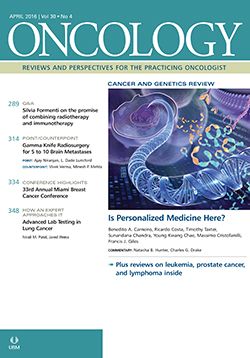Silvia Formenti on the Promise of Combining Radiotherapy and Immunotherapy to Treat Cancer
During the past decade, scientific evidence has emerged that shows that radiotherapy can induce: A) immunogenic cell death, a form of cancer cell death that is effectively signaling to the immune system; and B) a series of “danger” and pro-immunogenic signals that are sensed by the host’s immune system, and can be harnessed to reject the tumor.
Oncology (Williston Park). 30(4):289, 292.

Silvia Formenti

1.Can you explain how radiotherapy and immunotherapy work together to elicit responses in certain patients?
Dr. Formenti: At the time of clinical diagnosis, most cancers have already established multiple mechanisms to escape control of the host’s immune system, which results in varied degrees of tolerance to their growth. Particularly at the tumor site, cancer cells are embedded in a prevalently immunosuppressive microenvironment, which is difficult to subvert; even with the help of current immunotherapy agents such as immune checkpoint blockade, only a minority of patients with solid tumors experience a response to treatment. Radiotherapy is widely used as an anticancer modality that is based on focusing the damaging effects of ionizing radiation to the tumor and its microenvironment. During the past decade, scientific evidence has emerged that shows that radiotherapy can induce: A) immunogenic cell death, a form of cancer cell death that is effectively signaling to the immune system; and B) a series of “danger” and pro-immunogenic signals that are sensed by the host’s immune system, and can be harnessed to reject the tumor. When radiotherapy is used alone, these effects are generally insufficient at subverting the tumor-specific immunosuppression that is present in cancer patients. However, when combined with immunotherapy, such as immune checkpoint blockade, localized radiotherapy can effectively immunize the patient against the irradiated tumor, converting the tumor into an individualized in situ vaccine. When successful, this acquired immune response enables both rejection of the irraidated tumor and of metastasis outside the radiation field, with mechanisms comparable to those acquired after vaccination that result in rejecting viral or bacterial infections. This out-of-the-field effect of local radiotherapy is called the abscopal effect, a phenomenon originally described by Mole et al[1] in 1953, which our group first connected to immune-mediated mechanisms.[2]
2. In what areas have you seen the greatest benefit from radiotherapy combined with immunotherapy?
Dr. Formenti: We have demonstrated the advantages of immunotherapy/radiotherapy combinations preclinically in multiple tumor models, and clinically in metastatic solid tumors,[3] particularly breast cancer and non–small-cell lung cancer (NSCLC). In the latter setting, anti–cytotoxic T-lymphocyte–associated antigen 4 (CTLA-4) therapy alone failed to demonstrate significant activity; however, we found preclinically,[4] and later clinically, that it is quite effective when combined with local radiotherapy. After we reported a successful case treated with ipilimumab (anti–CTLA-4) and radiation to a liver lesion,[5] we conducted a prospective study in 40 similarly chemotherapy-refractory patients with metastatic NSCLC. The objective response rate was 33% among the patients who completed 4 cycles of ipilimumab and a course of 3 to 5 fractions of radiation to one metastasis. These patients had a significantly better survival and many remain alive with controlled disease.[6]
3. “Personalized medicine” is usually thought of as a development that pertains mainly to medical oncology. In what ways are radiation oncologists increasingly able to offer a personalized medicine approach to their patients?
Dr. Formenti: In radiation oncology, the standard delivery of a dose of radiotherapy is very personalized, since it takes into account the specific size, shape, and anatomy of each recipient, as well as the unique position of cancer; each treatment is personalized from a geometric, geographic, and physical point of view. From a biological point of view, combining radiation with immunotherapy has further enhanced the personalized nature of radiotherapy. In fact, by eliciting an anti-tumor immune response that is specific to the individual cancer, radiotherapy combined with immune checkpoint blockade rises to the role of personalized medicine. In addition, we have strong preclinical and clinical evidence that irradiated patients responding to the combination tend to shift their T-cell receptor repertoire in circulating lymphocytes toward a more oligoclonal one; evidence that radiotherapy has induced new antigens or overexpressed existing ones to trigger a novel immune response against the tumor.
4. What other recent developments in the field of radiation therapy for breast cancer do you think are particularly exciting?
Dr. Formenti: First is the administration of radiotherapy to women with breast cancer in a prone position, similar to the way they are imaged at MRI. This approach both eliminates motion during treatment and allows for the breast to be displaced away from the chest by gravity, and be targeted while avoiding heart and lung.[7] By sparing normal tissue we can drastically reduce their dose exposure and prevent late toxicities, including radiation-induced lung cancers and cardiovascular mortality from breast radiation. Another exciting development is the efficacy and safety of shorter radiation regimens, which reduces the course of radiation from 6 weeks to 1 to 3 weeks. We have contributed to this research by converging the prone setup with the use of fewer larger fractions of radiation, which has drastically reduced the risk to normal tissue while maintaining optimal efficacy in tumor control.[8,9]
Financial Disclosure: Dr. Formenti has received grant/research support from Eli Lilly, Janssen Biotech, and Regeneron; she is on the speaker’s bureau of Varian; and she is on the advisory committee of AstraZeneca, Bristol-Myers Squibb, Eisai, and GlaxoSmithKline.
References:
1. Mole RH. Whole body irradiation: radiobiology or medicine? Br J Radiol. 1953;26:234-41.
2. Demaria S, Ng B, Devitt ML, et al. Ionizing radiation inhibition of distant untreated tumors (abscopal effect) is immune mediated. Int J Radiat Oncol Biol Phys. 2004;58:862-70.
3. Golden EB, Chhabra A, Chachoua A, et al. Local radiotherapy and granulocyte-macrophage colony-stimulating factor to generate abscopal responses in patients with metastatic solid tumours: a proof-of-principle trial. Lancet Oncol. 2015;16:795-803.
4. Demaria S, Kawashima N, Yang AM, et al. Immune-mediated inhibition of metastases after treatment with local radiation and CTLA-4 blockade in a mouse model of breast cancer. Clin Cancer Res. 2005;11(2 Pt 1):728-34.
5. Golden EB, Demaria S, Schiff PB, et al. An abscopal response to radiation and ipilimumab in a patient with metastatic non-small cell lung cancer. Cancer Immunol Res. 2013;1:365-72.
6. Golden EB, Chachoua A, Fenton-Kerimian MB, et al. Abscopal responses in metastatic non-small cell lung cancer (NSCLC) patients treated on a phase 2 study of combined radiation therapy and ipilimumab: evidence for the in situ vaccination hypothesis of radiation. Int J Radiat Oncol Biol Phys. 2015;93:S66-S67.
7. Formenti SC, DeWyngaert JK, Jozsef G, Goldberg JD. Prone vs supine positioning for breast cancer radiotherapy. JAMA. 2012;308:861-3.
8. Osa EO, DeWyngaert K, Roses D, et al. Prone breast intensity modulated radiation therapy: 5-year results. Int J Radiat Oncol Biol Phys. 2014;89:899-906.
9. Formenti SC, Hsu H, Fenton-Kerimian M, et al. Prone accelerated partial breast irradiation after breast-conserving surgery: five-year results of 100 patients. Int J Radiat Oncol Biol Phys. 2012;84:606-11.
